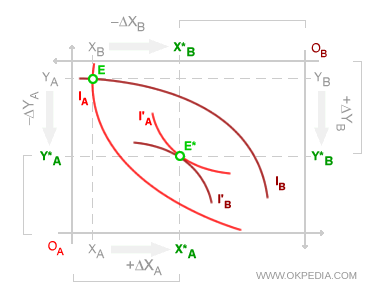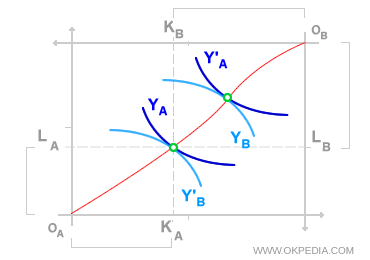Edgeworth Box Equilibrium
The equilibrium in the Edgeworth box is reached at the point where the indifference curves of the two economic agents are tangent. An Edgeworth box illustrates the preferences of two consumers using their respective indifference curves. Consumer A’s curves are convex toward origin OA, while those of consumer B are convex toward origin OB. At the point of tangency, both consumers face the same marginal rate of substitution, marking a stable and mutually beneficial equilibrium. For instance, assume consumer A is initially endowed with XA units of good X and YA of good Y, while consumer B holds XB and YB. These endowments are represented by point E in the Edgeworth box, lying on the indifference curves IA and IB for each consumer.

Point E is not a stable equilibrium because both consumers can increase their utility through trade. Consumer A benefits by trading away some of their YA to obtain more XA, while consumer B gains by exchanging part of their XB for additional YB. This exchange process continues until they reach point E* - the contract point - where each consumer moves to a higher, more preferred indifference curve: I′A and I′B. At this point, the curves are tangent, indicating that the marginal rate of substitution between the two goods is equal for both agents.
MRSA = MRSB
The equilibrium point E* reflects a new post-trade allocation - (X*A, Y*A) for A and (X*B, Y*B) for B - where both consumers are better off, having reached more advantageous indifference curves. Moreover, E* represents a Pareto-optimal allocation: from this point onward, it is impossible to make one consumer better off without making the other worse off. Any alternative allocation starting from E* would necessarily involve a trade-off in utility between the two.
Efficient Production Equilibrium
In the Edgeworth production box, an efficient allocation of input resources between the production of goods A and B is found at the point where their respective isoquant curves are tangent.

When firms operate on more outward (and thus more productive) isoquants, they achieve higher levels of output (Y′A > YA; Y′B > YB). Tangency between the isoquants indicates that the marginal rate of technical substitution of inputs is equal across both production processes.
MRTSA = MRTSB
The set of all tangency points between the two families of indifference curves forms a continuous path from origin OA to OB, known as the “contract curve”. Each point along this curve represents a Pareto-efficient allocation. In the production version of the Edgeworth box, the corresponding set of isoquant tangency points identifies all Pareto-efficient input allocations.
 Core of the Economy. The set of all efficient exchanges that can arise from a given initial endowment E is referred to as the core of the economy. It is defined by the intersection of the initial indifference curves with the contract curve.
Core of the Economy. The set of all efficient exchanges that can arise from a given initial endowment E is referred to as the core of the economy. It is defined by the intersection of the initial indifference curves with the contract curve.
